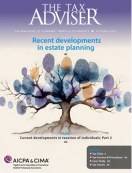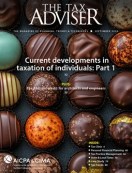The IRS provided a simplified method for taxpayers to apply for relief for various late S elections
S Corporation Income Taxation
2012 Best Article Award
Winners of The Tax Adviser’s 2012 Best Article Award.
Understanding the Tax Consequences of S Corporation Redemptions to a Shareholder
While an analysis of the tax consequences of a redemption to the shareholder usually begins with whether the transaction qualifies for sale or exchange treatment, another starting point is whether the S corporation has accumulated earnings and profits.
QSub Status Is Not Property of Bankruptcy Estate
An S corporation’s revocation of its S corporation status, which caused its QSub subsidiary to lose its status as a QSub, was not a post-bankruptcy-petition transfer of property of the QSub’s bankruptcy estate.
QSub Election Does Not Increase Shareholder Stock Basis
The Tax Court held that shareholders of an S corporation improperly increased the adjusted basis of their S corporation stock when the S corporation made a QSub election for its wholly owned C corporation subsidiary.
Final Rules on Acceleration of COD Income Deferral Are Issued
The IRS issued final regulations on the rules to accelerate COD income that taxpayers elected to defer over a five-year period when an applicable debt instrument was reacquired by the issuer or a related party in 2009 or 2010.
LIFO Inventory Considerations When Making a C-to-S Conversion
A taxpayer valuing its inventory under the last-in, first-out (LIFO) method should consider two significant implications for taxable income when converting from a C corporation to an S corporation.
Check-the-Box: A Trap for the Unwary
It has never been easier to effect the choice of operating as a sole proprietorship, partnership, or corporation for federal income tax purposes; however, sometimes unforeseen problems can result.
Deducting S Corporation Losses to Extent of Shareholder Basis
An S corporation shareholder reports corporate income or loss on the personal income tax return for the year in which the corporate year ends; losses or deductions passed through to the shareholder first reduce stock basis, then loss amounts are applied against debt basis.
IRS Not Allowed to Reclassify Passive Activity Income
The Tax Court held the IRS could not reclassify the taxpayer’s income from the rental of cellphone towers and the land they were situated on to his wholly owned S corporation as nonpassive income under the self-rental rule.
Debt Discharge Under Sec. 108: Partnerships vs. S Corps.
As tax liability for COD income gives many taxpayers an unpleasant surprise in today’s economy, its tax treatment continues to be a focal point for tax professionals in tax planning and preparation.
Providing Sec. 132 Fringe Benefits to S Corporation Employees
S corporations can offer employees the same fringe benefits as other business entities; however, so-called 2% shareholders are treated as partners for fringe benefit purposes. Work related fringe benefits are an exception.
Measuring Insolvency Under Sec. 108
While determining if a taxpayer is bankrupt is straightforward, determining whether a taxpayer is insolvent can be tricky.
Inadvertent S Corp. Terminations
When an S election is made, requirements must be met to avoid an inadvertent termination of S status.
Planning for Redemptions of S Corporation Stock Using Contingent Payments
When shareholders of an S corporation choose to part ways, they often do so by redeeming a departing shareholder’s stock.
How Changes in Corporate Tax Rate Can Affect Choice of C vs. S Corp.
This item examines the effect of the proposed lower corporate tax rates in an analysis of the tax results of converting an S corporation to a C corporation.
Current Developments in S Corporations
During the period of this S corporation tax update, some major changes that directly affect S corporations took place. This article also presents tax planning ideas for S corporations and their shareholders.
Santa Clara Valley Housing Group: An S Corporation Abusive Tax Shelter
Consideration of tax shelter case about whether warrants issued by an S corporation are a prohibited second class of stock reveals that the entire tax shelter is an arrangement that is a second class of stock.
S Corporation Shareholder Basis From Bona Fide Indebtedness
The IRS issued proposed regulations on the subject of when an S corporation shareholder can increase his or her basis in the S corporation’s stock based on loans to the corporation.
Reporting Life Insurance Transactions by S Corporations
There is room for disagreement, if not confusion, over how to report transactions involving life insurance on the tax returns of S corporations.
TAX PRACTICE MANAGEMENT
2025 tax software survey
AICPA members in tax practice assess how their return preparation software performed during tax season and offer insights into their procedures.














